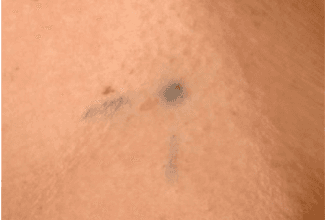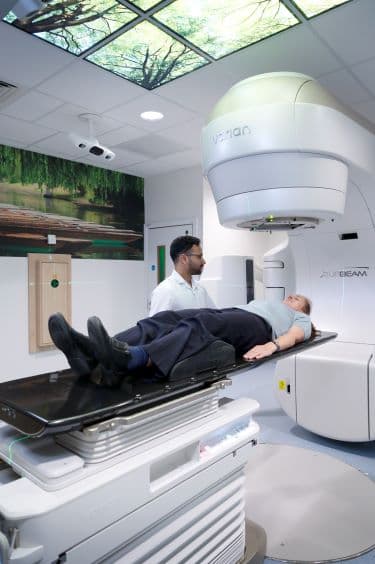Treatment
You might have radiotherapy:
after surgery
to shrink and control the cancer for as long as possible
to help relieve symptoms
You might have radiotherapy on its own or with chemotherapy (chemoradiotherapy).
Having chemotherapy helps the radiotherapy work better but can also increase side effects. For chemoradiotherapy you usually have the chemotherapy drug capecitabine.
Radiotherapy after surgery is called adjuvant therapy. You might have this treatment because:
your surgeon thinks there may be cancer cells left behind after your operation
cancer cells were found in the your surgeon took out when you had your surgery
You usually have a course (series of sessions) of radiotherapy treatment over 4 or 5 weeks. You will have around 20-25 sessions of radiotherapy. Treatment is usually Monday to Friday.
At the end of your course of treatment you may have a boost of additional radiotherapy. You are most likely to have adjuvant therapy as part of a clinical trial.
You may have radiotherapy to relieve the symptoms of advanced gallbladder cancer. Or if it isn’t possible to completely remove your cancer with surgery, because it has spread too far.
The treatment will not cure the cancer, but it may help to shrink it or slow it down. This is called radiotherapy. You often have this in fewer fractions and sometimes it is just one treatment. Palliative radiotherapy has fewer side effects.
Your doctor will discuss with you how many sessions you need.
You usually have external radiotherapy. This means that a radiotherapy machine aims the radiation beams at the cancer.
There are different types of external radiotherapy. Your doctor decides which is best for you.
You might have a type of external radiotherapy called conformal radiotherapy or intensity modulated radiotherapy (IMRT). These shape the radiation beams to closely fit the area of the cancer.
Find out more about the different types of external radiotherapy
SBRT gives radiotherapy from many different positions around the body. The beams meet at the tumour. This means the cancer receives high amounts (doses) of radiation, but the surrounding tissues only get a low dose. This lowers the risk of side effects.
Your doctor might ask you to enter a clinical trial looking at SBRT for gallbladder cancer.
Read more about clinical trials and gallbladder cancer
Before you begin your treatment, the radiotherapy team carefully plan your external beam radiotherapy. This means working out how much radiation you need to treat the cancer and exactly where you need it.
Your planning appointment takes from 15 minutes to 2 hours.
You usually have a planning CT scan in the radiotherapy department.
The scan shows the cancer and the area around it. You might have other types of scans or x-rays to help your treatment team plan your radiotherapy. The plan they create is just for you.

Your radiographers tell you what is going to happen. They help you into position on the scan couch. You might have a type of firm cushion called a vacbag to help you keep still.
The CT scanner couch is the same type of bed that you lie on for your treatment sessions. You need to lie very still. Tell your radiographers if you aren't comfortable.
You might need an injection of contrast into a vein in your hand. This is a dye that helps body tissues show up more clearly on the scan.
Before you have the contrast, your radiographer asks you about any medical conditions or allergies. Some people are allergic to the contrast.
Once you are in position your radiographers put some markers on your skin. They move the couch up and through the scanner. They then leave the room and the scan starts.
The scan takes about 5 minutes. You won't feel anything. Your radiographers can see and hear you from the CT control area where they operate the scanner.
The radiographers make pin point sized tattoo marks on your skin. They use these marks to line you up into the same position every day. The tattoos make sure they treat exactly the same area for all of your treatments. They may also draw marks around the tattoos with a permanent ink pen, so that they are clear to see when the lights are low.

The radiotherapy staff tell you how to look after the markings. The pen marks might start to rub off in time, but the tattoos won’t. Tell your radiographer if that happens. Don't try to redraw them yourself.
You might have to wait a few days before you start treatment.
During this time the physicists and your radiographer doctor (clinical oncologist) decide the final details of your radiotherapy plan. They make sure that the area of the cancer will receive a high dose and nearby areas receive a low dose. This reduces the side effects you might get during and after treatment.
Read more about radiotherapy planning
Radiotherapy machines are very big and could make you feel nervous when you see them for the first time. The machine might be fixed in one position. Or it might rotate around your body to give treatment from different directions. The machine doesn't touch you at any point.
Before your first treatment, your will explain what you will see and hear. In some departments, the treatment rooms have docks for you to plug in music players. So you can listen to your own music while you have treatment.

The radiographers help you to get onto the treatment couch. You might need to raise your arms over your head.
The radiographers line up the radiotherapy machine using the marks on your body. Once you are in the right position, they leave the room.
You need to lie very still. Your radiographers might take images (x-rays or scans) before your treatment. This is to make sure that you're in the right position. The machine makes whirring and beeping sounds. You won’t feel anything when you have the treatment.
Your radiographers can see and hear you on a CCTV screen in the next room. They can talk to you over an intercom and might ask you to hold your breath or take shallow breaths at times. You can also talk to them through the intercom or raise your hand if you need to stop or if you're uncomfortable.
The short video below shows how you have radiotherapy.
External radiotherapy won't make you radioactive. It's safe to be around other people, including pregnant women and children.
Radiotherapy for gallbladder cancer can cause side effects. You may have only a few side effects, or you may have several. This will depend on how long you have radiotherapy for. Also if you have it with other treatments such as chemotherapy.
The side effects you have will depend on what tissues and organs are in the way of the radiotherapy beam.
Side effects tend to start a week after the radiotherapy begins. They gradually get worse during the treatment and for a couple of weeks after the treatment ends. But they usually begin to improve after around 2 weeks or so.
Some of the side effects include:
You might feel tired during your treatment. It tends to get worse as the treatment goes on.
Various things can help you to reduce tiredness and cope with it, such as exercise. Some research has shown that taking gentle exercise can give you more energy. It's important to balance exercise with resting.
You might feel sick at times. Let your treatment team know if you feel sick, as they can give you anti sickness medicines.
Your skin might go red or darker in the treatment area. You might also get slight redness or darkening on the other side of your body. This is where the radiotherapy beams leave the body.
The red or darker areas can feel sore. Your radiographers will give you creams to soothe your skin. The soreness usually goes away within 2 to 4 weeks of ending the treatment. But your skin might always be slightly darker in that area.
The hair in that area might also fall out.
Radiotherapy to the tummy (abdomen) can cause diarrhoea. Drink plenty of fluids and let your doctor know if you have frequent diarrhoea.
The following video talks about the general side effects of radiotherapy. This video is around 8 minutes.
Last reviewed: 12 Oct 2023
Next review due: 12 Oct 2026
Gallbladder cancer is when abnormal cells in the gallbladder start to divide and grow in an uncontrolled way.
The treatment you might have depends on the size and type of your gallbladder cancer and whether it has spread.
Get practical and emotional support to help you cope with a diagnosis of gallbladder cancer, and life during and after treatment.
Advanced gallbladder cancer is cancer that has spread outside the gallbladder into lymph nodes or nearby organs. Or that has spread to another part of the body such as the lungs (secondary or metastatic gallbladder cancer).
Gallbladder cancer is a cancer that begins in the gallbladder, which is part of the biliary system. It is quite rare in the UK and more common in women than in men.

About Cancer generously supported by Dangoor Education since 2010. Learn more about Dangoor Education
Search our clinical trials database for all cancer trials and studies recruiting in the UK.
Meet and chat to other cancer people affected by cancer.
Questions about cancer? Call freephone 0808 800 40 40 from 9 to 5 - Monday to Friday. Alternatively, you can email us.